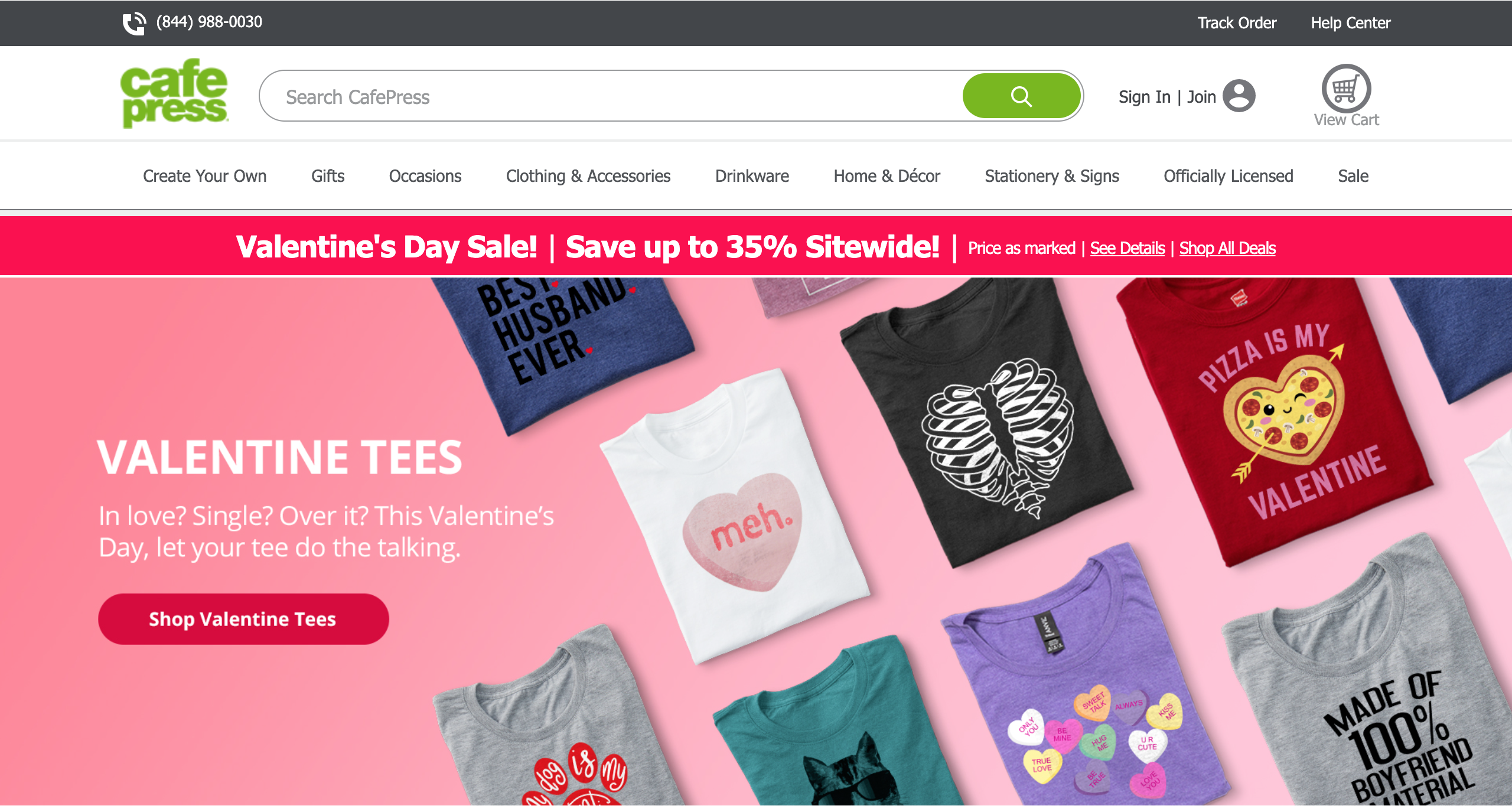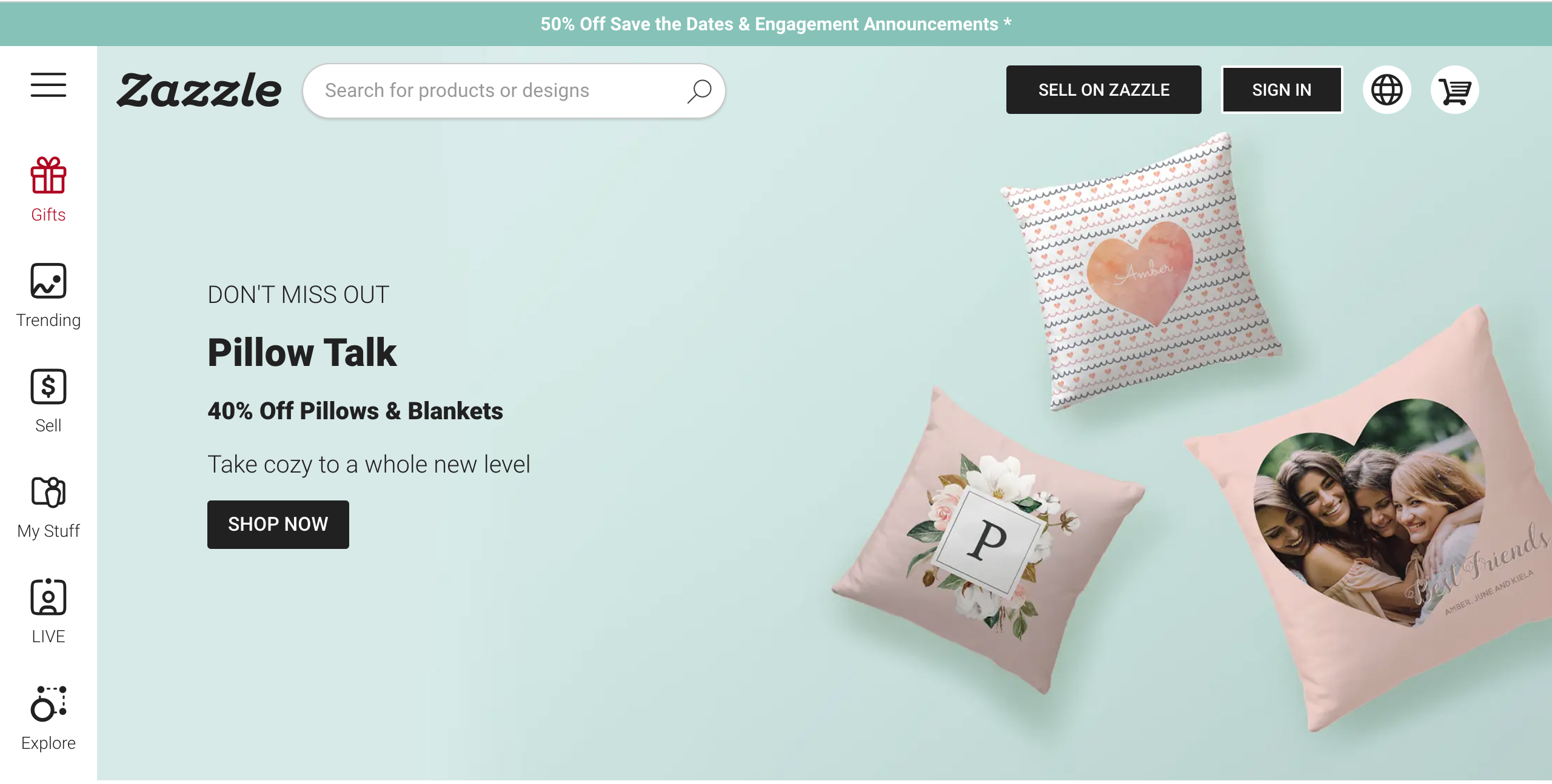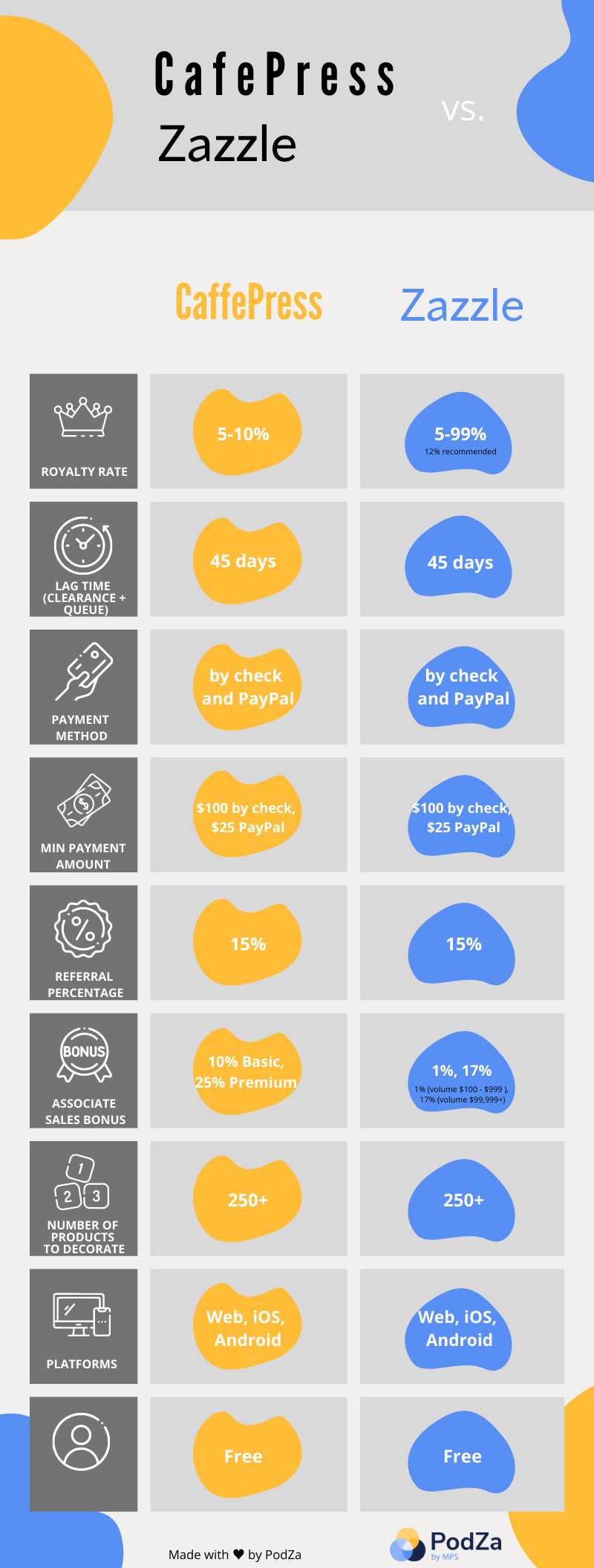CafePress vs Zazzle: Which POD Website Is Better For Artists
Both continuous IT developments and permanent COVID restrictions are encouraging people to find opportunities for earning money from home. In contrast to specs from many other domains, designers and artists are familiar with some sorts of personal earnings such as passive income and individual self-marketing. The so-called POD (print-on-demand) platforms have been offering various income options for decades.
CafePress and Zazzle are popular platforms where artists and designers can share their artworks with a wide consumer audience. Moreover, the inherent print-on-demand services turn pure creativity into marketable material objects that bring income to both artists and platforms. The POD approach proved to be sustainable enough to let dozens of alternatives to CafePress and Zazzle appear on the market. Hence, the CafePress vs Zazzle comparison is worth doing to help thousands of people select the most appropriate income-generating POD platform. Besides, a brief explanation of how POD services allow home-based designers to sell products on the internet won’t go amiss.
Table of Contents
Tips on working with POD portals
How POD websites work
Founders of print-on-demand services such as CafePress and Zazzle have long realized that customization of consumer products seems to remain a sustainable marketing trend for years and years. On the one hand, a t-shirt with an unparalleled print design deserves to be sold faster and for a higher price than serial analogs do. On the other hand, modern gadgets and computers allow millions of common people to create unique visuals in a digital format. The remaining task is to provide artists with an opportunity to see their artworks printed on various material goods.
This is exactly what CafePress and Zazzle as well as similar sites do. Every POD website is a digital stock of self-made visuals and a printing factory two-in-one. Art enthusiasts upload their craft designs on the website while the platform promotes the visuals among potential customers on the internet. Besides, a POD service has a warehouse with various goods on which the artworks can be printed on demand. The greater the variety of “blank” carriers is the larger the audience of potential customers visiting a POD service.
A selection between CafePress and Zazzle is not limited by the list of items they offer, however. Since the POD business model is relatively mature, there are some other aspects and features that matter while working with the platforms. The covered user audience depends on both the maturity of a platform and the promotional tools applied. Zazzle is leading in it when comparing CafePress vs Zazzle.
Media franchises partnering with a platform constitute another parameter of popularity. Movies, cartoons, computer games, TV shows, as well as various organizations beyond media such as the Marine Corps, for example, add an additional impetus to pay attention to one or another POD website. Both CafePress and Zazzle are rich with partnering brands.
Yet another aspect to consider is a set of services offered to both designers and users. This is about earning opportunities beginning from launching a personal e-shop on the POD portal and up to affiliated partnership paid with commissions for online promotion. CafePress and Zazzle differ in this aspect a little bit, but more on that later.
And the last but not least decisive factor of cooperation with any POD service is the service fee that platform owners retain from each deal. The design royalty is determined by artists themselves when indicating the markup price for every sold item. The extent of arbitrariness, however, is regulated in certain limits by both CafePress and Zazzle.
Where to Find Images for Your Print on Demand Merch?
CafePress
In a nutshell:
- Royalty rate: 5% - 10%
- Lag time (clearance + queue): 45 days
- Payment methods: by check and PayPal
- Min payment amount: $100 (by check), $25 (PayPal)
- Referral percentage: 15%
- CafePress Shop added price: 10% (Basic), 25% (Premium)
- Number of products to decorate: 250+
- Account creation: free
- Platforms: Web, iOS, Android
CafePress Help Center
CafePress was founded in California in 1999. Over time, the company's head office moved to Kentucky. The project has received numerous business awards as a user-friendly consumer-oriented service. The company is not alienated from merging & acquisitions: Imagekind printing company along with Canvas On Demand was acquired by CafePress while CafePress itself was purchased by Snapfish in 2018. The POD business model of CafePress is clear and multifaceted. Users can upload various visuals including text and logo to be printed on a great variety of material products.
The range of design carriers available on CafePress really impresses: customers can select items through different categories. The holidays & occasion category including gifts for birthdays or weddings goes in parallel with the other categories such as clothing, drinkware, home & decor, etc. Special licensed gifts cover a bunch of famous brands from Movies & TV, comics, games, universities, military, etc. You can find all Marvel heroes there along with Pepsi, ABC, U.S. Air Force, and the like.
In addition to the official web portal, mobile apps for both iOS and Android are available. Besides, CafePress is followed by large fan audiences on social media such as Facebook, Instagram, Pinterest, and Twitter. The sign-up procedure is facilitated by the Facebook integration button, by the way.
Designers can earn with both their own unique artworks and the Fan Portal where famous brands’ requirements are indicated. At the same time, even those who stand far from Photoshop can earn with CafePress by establishing relationships with the service as affiliate marketing partners. Such a binary business model is widely accepted by both CafePress and Zazzle as well as all the other POD alternatives.

Zazzle
In a nutshell:
- Royalty rate: 5% - 99% (12% recommended)
- Lag time (clearance + queue): 45 days
- Payment methods: by check and PayPal
- Min payment amount: $100 (by check), $50 (PayPal)
- Referral percentage: 15%
- Associate Sales Bonus: 1% (volume $100 - $999 ), 17% (volume $99,999+)
- Number of products to decorate: 250+
- Account creation: free
- Platforms: Web, iOS, Android
Zazzle Help Center
Three Beaver brothers founded Zazzle in 2005 with the help of some of Google’s investors. They received about $46 million as seed capital during 2005-2007 to start the project from scratch. TechCrunch awarded Zazzle as “the best business model” in 2007. With the head office based in California, Zazzle was recognized as one of the Hottest Silicon Valley Companies in 2010. Hence, the company is younger than its main competitor in the CafePress vs Zazzle comparison while having a much more dynamic launch in terms of investments.
Zazzle’s business model does not differ from CafePress’s one in any significant way. Artists can upload their designs to be printed on a great variety of physical carriers upon requests of customers. The user interface of the Zazzle website is created to resemble some sort of graphic editing software with a typic sidebar. A clear appeal to artists seems to be in such a design.
When comparing CafePress and Zazzle in terms of the physical objects for printing, Zazzle offers a wider range of carriers. Besides, there is a section where designers can try their hand at virtual backgrounds for Zoom that has become one of the most burning channels of communication during the recurrent COVID lockdowns.
Famous brands and franchises constitute the matter of competition between CafePress and Zazzle. The latter can boast Star Wars, Pixar, Disney, as well as a bunch of popular brands from pop culture and media. It seems Marvel, Sesame Street, US Army, and some other brands find nothing special to be present at both competing CafePress and Zazzle.
A list of social media where Zazzle promotes itself is larger than the media coverage of CafePress. Zazzle has official profiles on Etsy, Snapchat, Facebook, Instagram, YouTube, Twitter, and LinkedIn. The Zazzle’s focus on the social media presence is apparent with such a feature as the Custom Meme Maker available on the website.
Different options to earn from Zazzle are available. Similar to CafePress, Zazzle proposes artists create designs according to the partnering brands’ requirements. Besides, there is a large range of consumer products for which unique designs can be created by every art enthusiast. In contrast to CafePress, Zazzle’s designers can add any royalty they wish to the “processed” goods. Besides, creators can become some sort of “native” designers for Zazzle’s customers when working according to customer orders received from the Zazzle marketplace. An affiliate program is the third earning opportunity inherent in both CafePress and Zazzle.

Tips on working with POD portals
Novice artists can find both CafePress and Zazzle very similar in terms of the POD business model. And this is so in fact. Some distinguishing attributes such as the lists of franchises and the ranges of physical goods do not change the way in which designers can earn from the POD websites. Some general tips on what to expect from the cooperation with either CafePress or Zazzle make sense for newcomers, therefore.
- When artists upload their artworks on POD websites such as CafePress and Zazzle, no risk is available for the artists except maybe the risk of wasting time and effort. The POD service owners bear all risks since they have invested a lot in everything related to the business model beginning from large warehouses of “empty” physical products and up to the promotion and shipping. That’s why the lion’s share of profit legitimately belongs to POD portals;
- The POD model implies highly customized products produced in a single copy oftentimes. This results in relatively high prices for end customers. Designers should keep this fact in mind while adding their royalty to the finished products not to make them entirely unaffordable for customers;
- The uploaded designings are checked by the POD services with special automated scripts on servers for consistency with the technical specifications of every available physical item to be decorated. However, the bot can hardly provide ideal results. Artists have to make their own efforts for full compliance, therefore;
- Both CafePress and Zazzle are quite liberal in terms of censorship: of course, the acceptable visuals must be free of explicit weapons, drugs, violence, and racism, but designers can never face a sort of “we already have enough designs of such a kind” rejection that is typical for many online image stocks. This unties the artists’ hands to play with numerous variations of color, shape, style, and font;
- On the one hand, Google indexation of all major POD websites is excellent to let random visitors select designs on their own with ease. On the other hand, millions of available images make the competition between designers fierce. They should run additional campaigns to promote their artworks on the internet to stand out against rivals;
- Similar to any other kind of online trade, designings for POD products sell well when artists have rich portfolios that are regularly updated with new images. It is recommended to add new designings for various products as frequently as possible. Besides, it is worth analyzing why some artworks sell better than others as well as developing a distinctive authorial style;
- Dozens of alternatives to CafePress and Zazzle are available on the market. They all utilize the same POD business model. Specific nuances of customer audiences, partnering brands, commission percentages, and sets of decorable items can be a decisive factor for a particular designer to choose such a POD alternative instead of CafePress or Zazzle. The most popular ones are Printful, Printify, Redbubble, Represent, etc.
Top Strategies to Successfully Sell your Print on Demand Merchandize Online
Conclusion
The present age of digital techs provides artists with opportunities to earn for living without having to leave their homes. Image editing software along with POD portals allows artists to sell their artworks in the form of prints on a variety of physical objects beginning from t-shirts and up to smartphone cases. CafePress and Zazzle are among the most popular POD services. Their customer audiences count millions of users worldwide. In addition, numerous decent alternatives to CafePress and Zazzle with similar POD business models are available on the market.
| CafePress | Zazzle | |
| Royalty rate | 5% - 10% | 5% - 99% (12% recommended) |
| Lag time (clearance + queue): | 45 days | 45 days |
| Payment methods: | by check and PayPal | by check and PayPal |
| Min payment amount: | $100 (by check), $25 (PayPal) | $100 (by check), $50 (PayPal) |
| Referral percentage | 15% | 15% |
| Associate Sales Bonus | 10% (Basic), 25% (Premium) | 1% (volume $100 - $999 ), 17% (volume $99,999+) |
| Number of products to decorate | 250+ | 250+ |
| Account creation | free | free |
| Platforms | Web, iOS, Android | Web, iOS, Android |
| More | CafePress Help Center | Zazzle Help Center |

Besides creating and selling designs on the portals, artists can establish affiliate partnerships with POD services to earn extra from them. Self-promotion capabilities inherent in POD portals help artists arrange quite a risk-free passive income in the days when working from home is becoming a new normal due to recurrent lockdowns.
Contact us to get assistance in choosing the most appropriate POD service that meets your style and artistic vision best.


 REQUEST A FREE DEMO
REQUEST A FREE DEMO